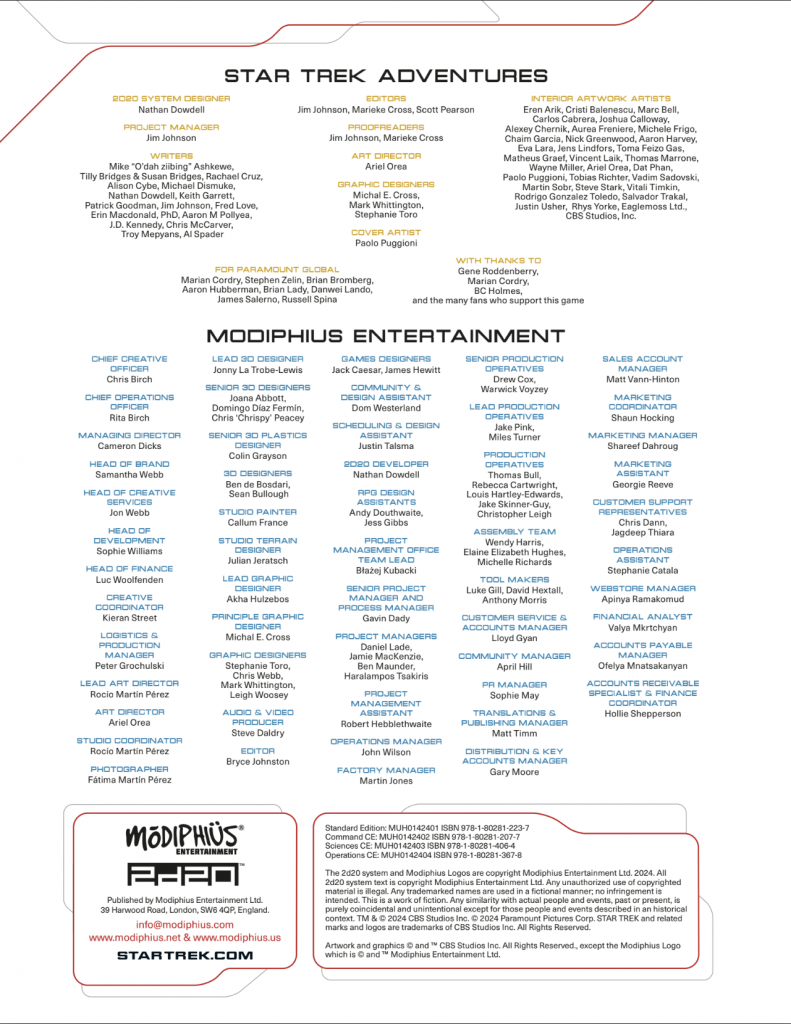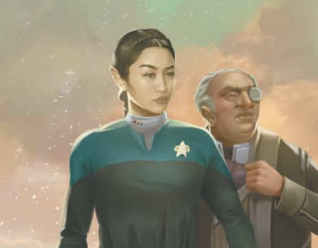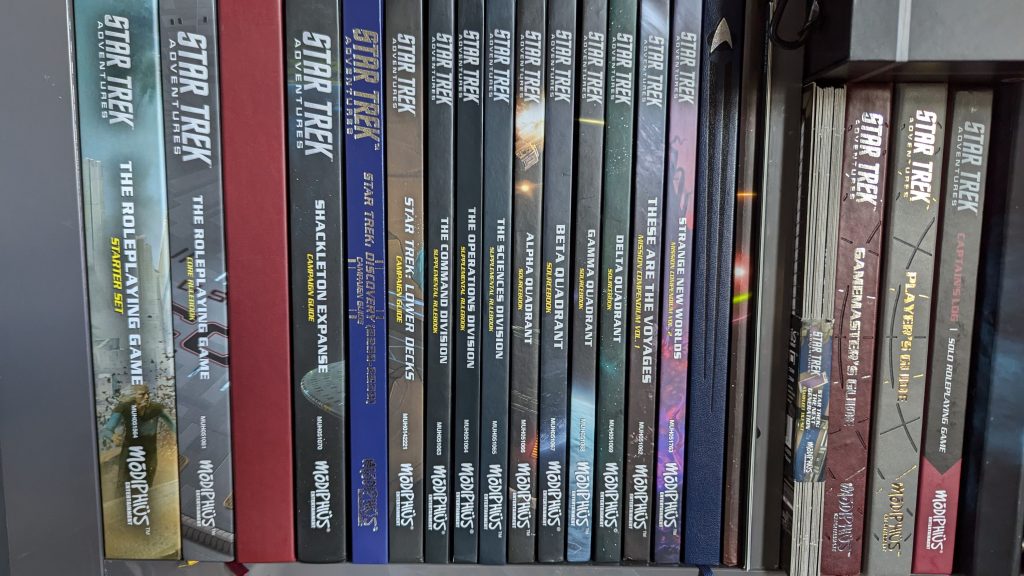The latest edition of Star Trek Adventures is here! With Star Trek: Picard coming to an end last year, Star Trek: Discovery bowing out a few months ago, Star Trek: Prodigy being unceremoniously cancelled (despite delighting Trek fans around the world) and Star Trek: Lower Decks finishing up later this year you could forgive a Star Trek fan who has become accustomed to the volume and variety of content we’ve been gifted in recent years for feeling a bit glum.
But fear not. We have Star Trek: Strange New Worlds, Star Trek: Starfleet Academy and a few TBDs on the horizon. If that still isn’t enough for you? Well. That’s where Modiphius comes in. Their Star Trek: Adventures tabletop RPG (TTRPG) gives any aspiring Star Trek storyteller and/or enthusiast the framework to craft their adventures with friends (or solo, through their ‘Captains Log’ variant). Here’s our review of their latest edition!
Keep reading, we’ve teamed up with Modiphius for a GIVEAWAY of their latest book!

What is Star Trek Adventures, and why is there a 2nd Edition?
The name may already be familiar to some. This isn’t an announcement of a brand-new game but rather a review of the new, refined, and revised rulebook. The first rulebook came out in 2017. It was quickly followed by a plethora of supplemental books, giving aspiring gamemasters and players everything they could possibly need to create a story, ship, and character within the Star Trek universe.
Whether you wanted to play an Engineer on one of Earth’s first NX starships during the Romulan War, the captain of a constitution class sent into deep space on a five-year mission that isn’t called Enterprise or through their Klingon core rulebook, a looked down upon medical officer on a Vor’cha class full of warriors! The possibilities were and are endless.
However, as with any new TTRPG, there were aspects of the game mechanics and systems that players and game masters found themselves butting heads with more often than not. They found that they were distracted from the stories they wanted to tell rather than enhance them.
This doesn’t mean that the first version (1E) was bad. This new rulebook should be viewed similarly to the new Dungeons & Dragons (D&D) rulebooks. A new set of rules that builds on a solid foundation. Especially as like those rulebooks, Star Trek Adventures 2E promises backwards compatibility with supplements and materials released for the last version.

The Basics
Star Trek: Adventures, like other Modiphius TTRPGs uses Modiphius’ own 2D20 system as it’s core framework. While you may have heard from D&D fans and players about the desirability of rolling a ‘natural’ 20. The 2D20 quickly sets itself apart by reversing the desirability of the numbers on the dice. When you’ve got a combadge pinned to your chest, you want a natural 1!
But the system doesn’t rely on blind rolls. Each character you create has a set of Attributes (broad physical and mental skill types that define how you prefer to approach a situation) and Departments (Disciplines in 1E), which represent the level of skill a character has in each of the broad Starfleet areas of expertise. Command, Security, Science, Conn, Engineering and Medicine. You add these 2 numbers together to get your target number, then aim to roll below it.
Rounding out a character are focuses, talents, values, attributes and traits. Focuses are more niche areas of expertise. Talents represent character-specific situational benefits. Values help to define the morality and belief system of your character. Then, attributes and traits represent species-specific character details that add some skill bonuses and more situational strengths and weaknesses.

More Mechanics
All of these character details and numbers come together in play not only as a roleplaying aid, but also to shape your character and groups ability to respond to tasks that the gamemaster presents you with. Each task has a difficulty level. Your goal as a group is to generate enough successes to succeed on the task. While easier tasks can be completed by single players, more difficult ones may require assistance from crewmates and even starships.
You get 1 success per dice that lands on or below the target number. If you have an applicable focus then each die that rolls equal to or less than the active department number on your character sheet counts as a critical success. Generating 2 successes. If you roll above the target number, or a natural 20. You generate a complication.
Star Trek: Adventures is a narrative led TTRPG that mechanically discourages rules lawyers and meta gaming in favour of player and game master cooperation and story building. Key mechanics of the game that stress this focus (heh) are the Momentum and Threat resources. Momentum is generated when you roll more successes than the task requires and is used by players to improve outcomes when they succeed. Whereas threat is generated when players fail, or take unnecessary risks and can be used by the gamemaster to raise the stakes.

Playing the Game
A play scenario that will look familiar to fans of the Voyager episode Scorpion: An 8472 bioship is detaching from a Borg Cube and heading towards Voyager. It powers it’s weapons so Captain Janeway orders, Tom Paris to get Voyager out of there at maximum warp. The gamemaster tells Robert Duncan McNeill that this is a Control and Conn task, as it’s a tense situation and the bioship is actively aiming for them it has a difficulty of 4. But, as it’s a ship action Voyager can assist.
Voyager has the ‘Improved Reaction Control System’ talent, which reduces the difficulty by 1. Paris’ has 11 Control and 5 Conn, so Robbie adds these numbers together to get his target number: 16. Paris has combat manoeuvres as a focus. He rolls an 5 and a 20, as he has an applicable focus the 5 is a critical success, giving him 2 successes, but the 20 generates a complication.
Hope is not lost though. As Voyager is assisting the task Robbie gets another die, because the ship is assisting it’s target number is based on Voyager’s applicable system and department numbers. In this case engines (11) and conn (4) for a target of 15. Robbie rolls a 14, gaining an additional success and the task succeeds.
The gamemaster describes how Paris bravely struggled against the inertial dampeners after a shot from the bioship grazed the shields and sent the ship into a spin, before managing to engage Voyager’s warp drive. But how pushing further into Borg territory is now more dangerous as Species 8472 are aware of who they are (the complication).

Notable Changes
There are many more mechanics to dive into, much more about starships for example. But if you want to learn about those I advise you pick up a copy of the rulebook yourself! Readers of this review will likely be keen to understand the main ways in which this book differs from the last (1E) rulebook.
The biggest change is the complete removal of challenge dice, these D6s were used in the last game as a part of a wide range of the games mechanics. This change also means that I now have to figure out what to do with the 20-odd challenge dice I had accumulated through buying all the various dice sets over the years…
Their removal has given rise to a number of new mechanics, such as impact for extended tasks and the shaken effect for ships but the most interesting changes are for personal combat. Characters and NPCs can now be inflicted with injuries by attacks and hazards, which can accumulate to the point the character becomes ‘defeated’, putting them out of action for the rest of the encounter/immediate scenario. Characters can choose to suffer from the stress mechanic instead of injuries, but this can lead to them becoming fatigued. Making it so they cannot act without penalties. Modiphius has more details on these changes in a blog post.


The New Core Rulebook
Having covered the essentials of the game, it’s time to get into the main event which is the new core rulebook! This is actually the 5th rulebook Modiphius has released for Star Trek Adventures. After the 1st edition the company released the Klingon Rulebook, the rules digest that came in the Tricorder set and the Captain’s Log solo roleplay variation.
While those books tinkered around the edge, this is the first major overhaul of the game’s mechanics. From the opening pages, it’s clear that the 2E rulebook was built with fan feedback at the forefront of the design process. The TNG LCARs page layouts, as aesthetically pleasing as they were, are out, bringing with them the common complaint of eye strain as players and gamemasters alike tried to quickly find a bit of information mid-game.
The new style follows in the footsteps of other releases such as the Captain’s Log rulebook. As well as the Players and Gamemaster’s Guides. So it will look familiar to those that picked up those releases. For those that haven’t, the design uses Star Trek inspired fonts and division colours for headers and highlights. While using a more conventional approach for the bulk of the content. Black text on a white background. Which is fantastic for readability (and highlighting, if you’re the type of person that does that).

Strange New Beginnings
From the cover alone, it’s clear that Modiphius is making the most of the Star Trek: Strange New Worlds aesthetic. While the first rulebook led the reader towards the a 24th Century setting from the first header, to the LCARs design, to the sector maps on the inside of the cover. This new version clearly put the 23rd century first during the design process. So don’t panic if you can’t spot Deep Space Nine on the inside cover, it’s probably still being built!
If you’re not a constitution class man though, don’t worry. The book gives a good overview in the ‘eras of play’ section of the various time periods groups can set their games in. This is however where I found the first error in the book. It’s definitely a nitpick, but in the 24th Century section and earlier quick overview of the Romulan Empire.
The book covers the story of how the Hobus star went supernova, resulting in the destruction of Romulus. This is the version of events given in the 2009 Countdown comics and Star Trek Online. But Star Trek: Picard established that in the ‘prime timeline’, it was actually the sun in the Romulus system that went nova.
While reading the book, it’s clear that Modiphius has taken onboard a lot of the feedback about the layout where the rules are concerned. It spends more time explaining the book and rules. Rather than giving examples and relying on readers to put the pieces together. For example, the first rulebook told players what kit they needed and how dice rolls worked. Before providing a two page example of a game play scenario, which used a number of mechanics that hadn’t been covered yet.


Structural Engineering
The new rulebook doesn’t do that. It has the same quick summary of required equipment and dice rolls. But this is followed by a summary of the rule books structure. A useful page that tells readers where to jump to get the information they need whether they’re preparing for a session, or mid game.
One of my main complaints about the previous rulebook was that as a Star Trek fan. A lot of it was… Somewhat redundant as well. The 2nd chapter was a 42 page summary of the United Federation of Planets. Handy for somebody new to Star Trek, but new fans probably aren’t the main target audience of a Star Trek themed TTRPG.
In contrast, the new book has a ‘Star Trek Primer‘. This still covers a lot of Star Trek information. But instead of introducing players with a deep dive on Bajor and the Cardassian Union. It communicates Star Trek history at a much more conceptual level. Dropping small bits of canon information while tying them into how players may want to develop their characters. It even has a few paragraphs on the Federation economy!


Artwork
For me, the artwork is always a highlight of any TTRPG book. This is an area where this book falls a little short of the first version. While the LCARs page layouts were often hard on the eyes, the LCARS display artwork accompanying the text, along with the character illustrations succeeded in delivering an artistically consistent book.
The new core rulebook brings in a range of artwork, and with this a range of quality. All the artists Modiphius have hired are undoubtedly incredibly talented. But there are clear examples, from even the front cover. Where the lack of artistic focus has impacted the final product. The most egregious issue, that crops up over and over again is combadges and combadge placement. But there are also some away team kit/uniform era mismatches.
The general aesthetic is also inconsistent. The book arbitrarily switches between artistic renditions of scenes; photorealistic ship renders from the likes of Thomas Marrone, and, most jarringly, Lower Decks-style illustrations. With that said, this type of inconsistency is very Star Trek, so I can’t complain about it too much!

Final Thoughts
A few art issues and canon conundrums aside, though, this is a very strong offering from Modiphius. As mentioned a few times in the review, it’s clear they’ve taken player feedback on board. It’s leaps and bounds ahead of the previous book in the areas that count. Accessibility, readability and structure. As a keen Star Trek: Adventures fan, part of me dreads doing another session 0 where I must explain the rule changes to my group. But the rest of me is keen to dive in with a revised set of mechanics that should make the game more fun. Whether you’re a gamemaster or player.
Trek Central – Star Trek Adventures – Second Edition GiveawayThe Star Trek Adventures 2nd Edition—Core Rulebook is available now in PDF format from Modiphius. A physical standard edition and limited editions in the three-division colours are coming soon!
More From Trek Central
- 🚨 Robert Picardo Returns For Star Trek: Starfleet Academy Series
- 🔥 NEW Trailer for Star Trek: Section 31!
Join the Star Trek conversation via our social media platforms:
- Facebook – https://www.facebook.com/TrekCentral
- Instagram – https://instagram.com/TrekCentral
- Twitter – https://twitter.com/TheTrekCentral
- YouTube – https://youtube.com/TheTrekCentral
- Mastodon – https://mastodon.social/@TrekCentral@universeodon.com
- Discord – https://discord.gg/fF2heMbfW8







